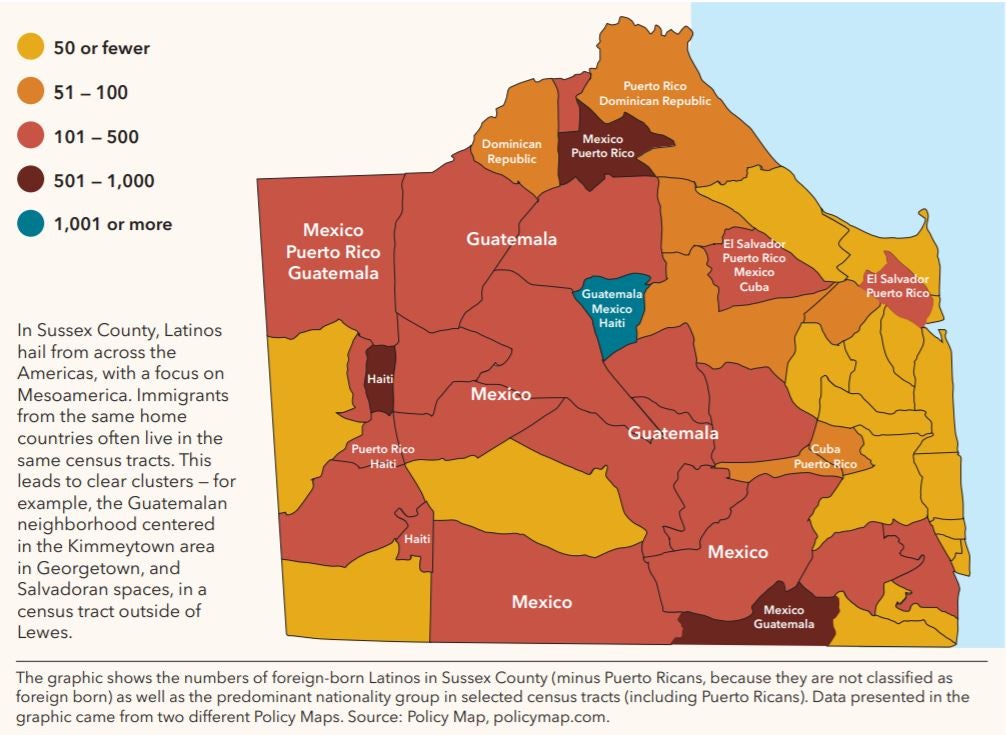Report Shows Latinx Boom in Southern Del., but There’s Work to do to Help Newcomers Thrive

Dina Sanchez said her late Mexican American father and El Salvador-born mother relocated from Texas to Sussex County, Del. about 30 years ago to open one of the first Spanish-speaking churches in the county.
The move was a culture shock, she said.
The Sanchez community’s in Texas close to the Mexican border was diverse. But in Delaware’s southernmost county, they were some of the first Latinx residents.
Sanchez said her parents recalled that when they first arrived, store employees would follow them around while they shopped.
Today, there are thousands of Latinx residents in Sussex County and many Latinx-owned businesses. The Sanchez’s church was one of the first Spanish-speaking churches in the county. Today, there are more than 10 in the town of Georgetown alone, Sanchez estimates.
“There’s more familiarity, more comfort, they’re exposed to different cultures and traditions within the Latino community, so very different from 30 years ago,” she said.
The Latinx community in Sussex County has grown to about 20,000 — 13 times what it was in 1990 — according to a Delaware Community Foundation report examining Latinx quality of life in the state’s southernmost county.
As resident and Delaware Hispanic Commission co-chair Charito Calvachi-Mateyko puts it, “Georgetown would be a ghost town without Latinos.”

Measuring the impact
Latinx residents pay millions in taxes every year, and almost three quarters are in the labor force. There’s also increased personal autonomy and entrepreneurship among the Latinx community in the county, according to the DCF report.
However, it also outlines a lack of access to high-paying jobs, quality housing and healthcare.
The report makes recommendations on how to address various needs of the population to ensure the community continues to flourish.
“In order to address growth, sustainability and opportunity for everybody in Delaware, we need to address it for everybody in Delaware. There’s been a 1,200% growth in the Latino community in the last 30 years in Sussex County. That’s a massive growth,” said Stuart Comstock-Gay, president and CEO of DCF.
“We have people living, working, paying $50 million in taxes every year,” he added. “They’re part of our community, and sometimes we don’t even see it. For all of us to thrive we need that community to thrive.”
Calvachi-Mateyko said during a time when there are fears of deportation, and increased threats of racism, the report sends an important message.
“Latinos in general create the wealth in this state,” she said. “We need to be very conscious of that and see the Latino community in a different way — especially those that prefer there won’t be any changes in the way they see America.”
Easier, but not easy for newer immigrants
Newer waves of immigrants have more opportunities than their predecessors, thanks to expanded immigrant services, according to the report. And second and third-generation Latinx residents say their parents paved the way for their success.
Residents who moved here several years ago are also starting to see their hard work pay off, according to the report.
There are twice as many Latinx-owned businesses in Sussex than 12 years ago and a 165% increase in income between 2013 and 2017.
“When [my parents] moved, they came to open a Spanish-speaking church, but they couldn’t live off two or three people in a church, so they both worked at chicken plants and a manufacturing company,” Sanchez said. “They moved here with nothing, no vehicle. They had a place to stay, but that was it. … At the same time, they were working full-time, making ends meet and trying to build a church in Sussex County,” Sanchez said.
“First-generation goals always have been that their children have the opportunities and success they didn’t. And for me personally it was a mindset, ‘You’re going to be better than this, it’s not a choice or an option,’” she said, chuckling. “‘You’re going to have a better education. You’re not going to have the same types of jobs we have. We are working so you can have a different type of life.’”
While many members of the community are thriving, there are still many challenges facing immigrants in Sussex County. Even though most Latinx Sussex residents hold a job and contribute $50 million in annual taxes, 80% still live in poverty.
“It broke my heart when one Latino was so proud, he is the supervisor, and I said, ‘How much are you earning?’ And of course, this was 5 years ago, but he said ‘$7.50.’ And I knew an American supervisor, an Anglo-Saxon American supervisor, would receive $15 for the same labor,” said Calvachi-Mateyko.
“The reality is in the big scale of things. Latinos are being used for cheap labor,” she added. “Even though they are making the wealth, that’s going to the one-tenth of the [top] tenth percent.”
Keys to success
A person’s economic mobility and quality of life rely heavily on immigration status, education and English language skills, the report notes.
Puerto Ricans, for example, who are U.S. citizens, don’t face the same uncertainty as some Latinx residents from other countries, according to some interviewed for the report. Meanwhile, undocumented immigrants face the fear of deportation daily and don’t have access to various services that require proof of residency.
They’re also more likely to take jobs while paid under the table, which makes them vulnerable to abuse, working long hours for low pay.
“They’ll start at these entry-level positions and do the hard labor, to the best of their abilities. And sometimes that results in them being abused and working many, many hours or working 87 hours and not having a break,” said someone surveyed in the report.
The majority of Sussex County Latinx residents immigrated from Guatemala and Mexico to escape various types of violence, according to the report.
“With no trust in local officials or the police, it is not unusual for Guatemalan immigrants to Sussex County to report that in their home country, they had to remain indoors after 8 p.m. or 9 p.m. because it was unsafe: ‘When I came here I felt a difference, security,’” the report reads.
Guatemalans and Mexicans, which make up most of Sussex County’s Latinx population, make up more than half of the state’s undocumented immigrants.
Guatemalans also have less access to educational opportunities — 9% of Guatemalans in Sussex County have a bachelor’s degree, compared to 55% for Puerto Ricans and 35% for Mexicans. In addition, there are many indigenous Guatemalans who speak their own language, not Spanish. That creates more barriers because most service providers are limited to English or Spanish.
One challenge outlined in the report is the relatively high rent prices compared to income levels. Census data shows housing ranges from $750 to $1,000 per month in Sussex County, and while the median income is $65,900, individuals are paying 30% of their income on housing. Those interviewed for the report said despite the rental prices, the properties are poor quality.
“There are a lot of locations where two and three families live in one house, a lot of substandard conditions and a lot of slumlord activity. It’s a big problem … code enforcement is really minimal around here, and the county code enforcement is all complaint-driven. So, if the code officers or if anybody in the county see something, they don’t necessarily have to act on it,” one person said.
Study participants also reported barriers to conventional U.S. health services, such as affordability, lack of access through employment, immigration status, transient living conditions and fear of exposure.
Calvachi-Mateyko said the political climate has made immigrants more uncertain than ever — and said children are bullied by their peers more than a few years ago. But she is encouraged and inspired by the outpouring of support in Sussex County. She said Spanish-speaking churches bring immigrants together, and those that settled years ago mentor newcomers.
“That dedication to provide is amazingly beautiful. They feel they need to do that to heal, to move on and have a community,” Calvachi-Mateyko said. “That creates a sense of belonging, a sense they can bring their children to this world. They give us an amazing example how they can forge a new life in spite of everything.”
The report makes several recommendations to provide services to the Latinx community in Sussex County, including additional English language classes, assistance in home buying, business incubators, and programs that help immigrants in their new community.
“They’re trying to navigate a system they don’t understand, so how can we help these people better understand where the supports are for getting healthcare for their children, getting their children into the schools and helping them thrive in the schools?” Comstock-Gay said.
Sanchez, who works for community organization La Colectiva de Delaware, agrees one of the most significant challenges Sussex Latinx residents face is navigating the system to help them with their individual needs.
“One of the biggest barriers we hear from the community is understanding the system and how to access resources,” she said. “There are lots of resources available in the community, but they don’t know about them. And sometimes even the people providing new services aren’t communicating what they have to offer. We’re really looking to bring these organizations and resources together to better serve the community.”
Source: WHYY
